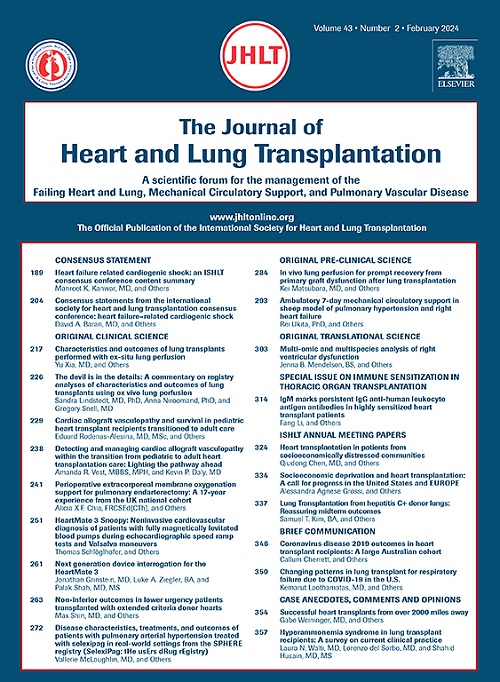支持Impella 5.5超过14天的患者的结局:心源性休克工作组注册分析。
IF 6
1区 医学
Q1 CARDIAC & CARDIOVASCULAR SYSTEMS
引用次数: 0
摘要
Impella 5.5 (ABIOMED, Danvers, MA)是一种微型轴流泵,目前在美国获得了长达14天的支持。然而,在临床实践中,它的使用时间更长,特别是作为心脏替代疗法(HRT)的桥梁。我们的目的是在一个大型的、多中心的注册研究中,确定使用Impella 5.5治疗10 ~ 14天的患者的特征和结果(死亡率和严重不良事件/ SAE)。方法:对2022-2024年间来自34个国际站点的心力衰竭(HF)或心肌梗死相关CS (MI-CS)患者的CSWG登记进行分析。将支持Impella 5.5 bb0 14天的患者与支持≤14天的患者进行基线特征比较。住院结果进一步分类为“有利”(心脏恢复,成功过渡到HRT并活着出院)或“不利”(死亡,需要升级到VA-ECMO)。使用单变量和多变量分析评估有利结果的预测因子。结果共927例患者使用了Impella 5.5,其中381例患者使用了该设备。两组(>或≤14天)的中位支持时间分别为23.9[21.2]天和7.1 [IQR 5.7]天。Impella 5.5 bb0 14天的患者更年轻(平均年龄57 vs 61岁)。与≤14天的队列相比(58% vs 38%), p14天的患者的HRT明显更高,p14天的患者支持时间延长,SAE发生率没有线性增加。结论:在FDA批准的持续时间超过14天的患者中,支持Impella 5.5的患者有很高的良好预后率,特别是作为HRT的桥梁。在更长时间内使用Impella 5.5需要在前瞻性研究中进一步调查。本文章由计算机程序翻译,如有差异,请以英文原文为准。
Outcomes of patients supported on Impella 5.5 for more than 14 days: A Cardiogenic Shock Working Group registry analysis
Background
The Impella 5.5 (ABIOMED, Danvers, MA) is a micro-axial pump that is currently approved for up to 14 days of support in the United States. However, in clinical practice it is being used for longer durations of time, especially as a bridge to heart replacement therapies (HRT). We aimed to define patient characteristics and outcomes (mortality and serious adverse events/SAE) in patients supported on Impella 5.5 for >14 days in a large, multi-center registry.
Methods
The Cardiogenic Shock Working Group (CSWG) registry enrolling consecutive patients in heart failure (HF) or myocardial infarction related CS (MI-CS) from 34 international sites between 2022 and 2024 was analyzed. Patients supported with Impella 5.5 >14 days were compared to those supported for ≤14 days for baseline characteristics. In-hospital outcomes were further classified as ‘‘favorable’’ (heart recovery, successful bridge to HRT and discharged alive) or ‘‘unfavorable’’ (death, need for escalation to veno-arterial extracorporeal membrane oxygenation [VA-ECMO]). Predictors of favorable outcomes were assessed using uni- and multi-variable analysis.
Results
A total of 927 patients were supported on Impella 5.5 of whom 381 had the device for >14 days. Median time of support in the 2 groups (> or ≤14 days) was 23.9 [21.2] and 7.1 [IQR 5.7] days, respectively. Patients with Impella 5.5 >14 days were younger (mean age 57 vs 61 years, p < 0.001), more likely to have HF-CS vs MI-CS (78% vs 61%; p < 0.001) and have a dilated left ventricle (left ventricular end diastolic dimension [LVEDD] 6.4 vs 5.9 cm, p = 0.002) and chronic kidney disease (38% vs 30%, p = 0.03) as compared to those supported ≤14 days. Baseline Society for Cardiovascular Angiography and Interventions (SCAI) stage, lactate, and vital signs were not significantly different. Unadjusted survival was higher (80% vs 68%, p < 0.001) in those supported for >14 days, with a significantly higher HRT for those supported for >14 days, compared to the ≤14 days cohort (58% vs 38%, p < 0.001). Less than a fourth (19.1%) had an SAE, with highest rates seen in MI-CS supported for ≤14 days. The majority (75%) of patients on support for >14 days had favorable outcomes with no linear increments in rates of SAE with prolonged duration of support.
Conclusion
Patients supported with Impella 5.5 beyond the Food and Drug Administration (FDA) approved duration of 14 days had high rates of favorable outcomes, especially as bridge to HRT. Use of Impella 5.5 for longer durations needs to be further investigated in prospective studies.
求助全文
通过发布文献求助,成功后即可免费获取论文全文。
去求助
来源期刊
CiteScore
10.10
自引率
6.70%
发文量
1667
审稿时长
69 days
期刊介绍:
The Journal of Heart and Lung Transplantation, the official publication of the International Society for Heart and Lung Transplantation, brings readers essential scholarly and timely information in the field of cardio-pulmonary transplantation, mechanical and biological support of the failing heart, advanced lung disease (including pulmonary vascular disease) and cell replacement therapy. Importantly, the journal also serves as a medium of communication of pre-clinical sciences in all these rapidly expanding areas.

 求助内容:
求助内容: 应助结果提醒方式:
应助结果提醒方式:


